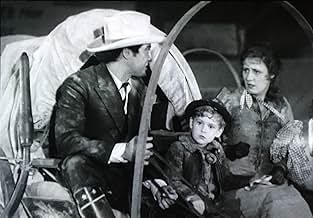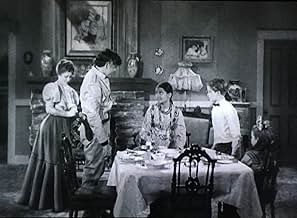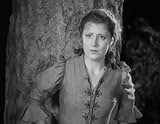IMDb रेटिंग
5.8/10
7.4 हज़ार
आपकी रेटिंग
अपनी भाषा में प्लॉट जोड़ेंA newspaper editor settles in an Oklahoma boom town with his reluctant wife at the end of the nineteenth century.A newspaper editor settles in an Oklahoma boom town with his reluctant wife at the end of the nineteenth century.A newspaper editor settles in an Oklahoma boom town with his reluctant wife at the end of the nineteenth century.
- 3 ऑस्कर जीते
- 7 जीत और कुल 5 नामांकन
Roscoe Ates
- Jesse Rickey
- (as Rosco Ates)
Judith Barrett
- Donna Cravat
- (as Nancy Dover)
Max Barwyn
- Sabra's Luncheon Greeter
- (बिना क्रेडिट के)
Frank Beal
- Louis Venable
- (बिना क्रेडिट के)
Tyrone Brereton
- Dabney Venable
- (बिना क्रेडिट के)
Dolores Brown
- Adult Ruby Big Elk
- (बिना क्रेडिट के)
फ़ीचर्ड समीक्षाएं
This is a comment following up to a previous post. Richard Dix was a big silent film star before Cimarron. He was one of the few silent actors who successfully made the transition to talking pictures. I hardly recognized Irene Dunne at first, this was only her second film. This film is fun to watch as the talent of the actors is evident. People must keep in mind that the sound quality, sets, etc. were all still relatively new in 1931. Actors and directors were accustomed to silent movies. The costumes, performances, and sets are quite good, in my opinion. Once gets a feel for how the home life, new life in the southwest, and the timeless snobbery of the town "ladies." The courtroom scenes are intense. The writing was realistic for the time period. Scathing accusatory and judgmental remarks to browbeat and break the woman's spirit. A very moving picture.
In fairness to Richard Dix's overacting, Charles Bickford, one of the great character actors ever, also overacted atrociously in "Anna Christie," which was made exactly one year earlier than "Cimarron." The majority of movies didn't go from being silent to talking until 1929 and "Cimarron" was filmed in 1930, so both these films were real early talking films and the performers had not learned to down scale their performances.
The editing and cinematography were outstanding, even revolutionary for that era. The film needs to be viewed in a historic context and not compared to current films. I do agree that "Cimarron" does not hold up as well during the march of time from 1930 to 2008 as does "Public Enemy," "Little Caesar," "Scarface" but it was a complex and ambitious film adaptation of a novel by an outstanding writer, Edna Ferber.
Richard Dix's character does stand up for and vehemently support fairness to Indians and prostitutes, which was a revolutionary idea for a movie made in 1930.
I did notice that Eugene Jackson, the young black teenager, worked for 60 years in the film business, including a recurring role in "Stanford and Son," and in "Julia." Richard Dix, a major star in silent films starting in the early 1920s, peaked around the time of "Cimarron" and by the second half of the 1930s was stuck in B films but did continue his career and stared in films until his retirement in 1947.
Irene Dunne went on to super stardom for the next 20 years and made quite a few classics (check out her film list in her biography.) It is amazing!
I want to compliment the other writers who are classic film lovers but do want to state that too many readers check the not helpful box instead of the helpful box when evaluating the reviews of others. I feel that they are being too picky. After all, we are a select group of people who appreciate old films and should have support each other more as a group, unless the review is vindictive or totally uninformed.
The editing and cinematography were outstanding, even revolutionary for that era. The film needs to be viewed in a historic context and not compared to current films. I do agree that "Cimarron" does not hold up as well during the march of time from 1930 to 2008 as does "Public Enemy," "Little Caesar," "Scarface" but it was a complex and ambitious film adaptation of a novel by an outstanding writer, Edna Ferber.
Richard Dix's character does stand up for and vehemently support fairness to Indians and prostitutes, which was a revolutionary idea for a movie made in 1930.
I did notice that Eugene Jackson, the young black teenager, worked for 60 years in the film business, including a recurring role in "Stanford and Son," and in "Julia." Richard Dix, a major star in silent films starting in the early 1920s, peaked around the time of "Cimarron" and by the second half of the 1930s was stuck in B films but did continue his career and stared in films until his retirement in 1947.
Irene Dunne went on to super stardom for the next 20 years and made quite a few classics (check out her film list in her biography.) It is amazing!
I want to compliment the other writers who are classic film lovers but do want to state that too many readers check the not helpful box instead of the helpful box when evaluating the reviews of others. I feel that they are being too picky. After all, we are a select group of people who appreciate old films and should have support each other more as a group, unless the review is vindictive or totally uninformed.
The outstanding but admittedly dated "Cimarron" dazzled audiences so much that it was a runaway Best Picture Oscar winner in 1931. The film is novelist Edna Ferber's epic tale of the early American settlements of Oklahoma from 1889 and goes to the economic unrest of the Stock Market crash of 1929. Richard Dix (Oscar-nominated) immediately moves his family out to the untamed land and starts a new life. Wife Irene Dunne (Oscar-nominated) has doubts not only about the new land, but also about her husband's adventurous nature. Dix is an individualist with itchy feet and thus he comes and goes as he pleases, but always seems to come through for his family and his adopted state when the chips are down. "Cimarron" is an abbreviated history of a land which was once wild and untamed that slowly became modern by the early-20th Century. The views upon African-Americans and Native Americans is given much air time here. Ferber's equally riveting "Giant" posed similar questions towards Texas' views of women and Hispanic Americans. She was a truly gifted writer and her novels were both adapted into stunning motion picture experiences. Wesley Ruggles' (Oscar-nominated) direction is a bit prodding and the film does stall a bit due to its length, but overall "Cimarron" is an important American movie that if nothing else created the legitimate Western genre. 4.5 out of 5 stars.
Cimarron was an early talkie that made great strides in sound, allowing natural interaction between the cast and a more natural movement of the camera, allowing the filming of some truly spectacular scenes. The shots of the Oklahoma Land Rush stampede involve ground-breaking sound and cinematography that make it one of the most realistically shot scenes up to that time. Other well filmed scenes include those of Osage's dusty streets with the camera tracking the main characters as they walk along while hundreds of extras bustle about them, showing the life of a busy boom town shortly after the land rush. Unfortunately, this is pretty much where my praise of this film ends.
This film stars Richard Dix as Yancey Cravat, a man who was born under a wandering star. Unfortunately, that didn't stop Yancey from taking a wife and having children, it just stopped him from taking any responsibility for that same wife and children. Through the years, Yancey chases one hair-brained scheme after another while his long-suffering wife Sabra (Irene Dunne) takes responsibility for the newspaper Yancey started but abandons time and again. Sometimes Yancey's adventures keep him home, other times they take him away for years at a time. The film focuses on Yancey's adventures, while the whole time I'm wondering what Sabra is up to. In modern times, her story is much more compelling and sympathetic than Yancey's.
Richard Dix's performance is quite hammy by modern standards. You'll find yourself laughing in places that were not intended to be funny by the film's creators, and in spite of your laughter, you'll still find Yancey to be completely unlikeable. He would make a great politician in the 21st century - he is very apt at doing one thing, saying another, and still finding time for splendid oratory. Unfortunately, this film was my introduction to Dix. I didn't see another one of his films for a long time and, when I did, I was surprised to find out how good he was in his smaller non-Academy recognized performances.
Remarkably, this film won the Oscar for Best Picture in 1931. Even more remarkably, Richard Dix was nominated for Best Actor for his performance in this film. Not remarkably, Irene Dunne was nominated for Best Actress for her performance, in spite of the lack of depth of the examination of her character in the film. Thus I'd say this film is worth it just to see the very good technical achievements it featured in sound and cinematography and Dunne's performance as the long suffering Sabra.
This film stars Richard Dix as Yancey Cravat, a man who was born under a wandering star. Unfortunately, that didn't stop Yancey from taking a wife and having children, it just stopped him from taking any responsibility for that same wife and children. Through the years, Yancey chases one hair-brained scheme after another while his long-suffering wife Sabra (Irene Dunne) takes responsibility for the newspaper Yancey started but abandons time and again. Sometimes Yancey's adventures keep him home, other times they take him away for years at a time. The film focuses on Yancey's adventures, while the whole time I'm wondering what Sabra is up to. In modern times, her story is much more compelling and sympathetic than Yancey's.
Richard Dix's performance is quite hammy by modern standards. You'll find yourself laughing in places that were not intended to be funny by the film's creators, and in spite of your laughter, you'll still find Yancey to be completely unlikeable. He would make a great politician in the 21st century - he is very apt at doing one thing, saying another, and still finding time for splendid oratory. Unfortunately, this film was my introduction to Dix. I didn't see another one of his films for a long time and, when I did, I was surprised to find out how good he was in his smaller non-Academy recognized performances.
Remarkably, this film won the Oscar for Best Picture in 1931. Even more remarkably, Richard Dix was nominated for Best Actor for his performance in this film. Not remarkably, Irene Dunne was nominated for Best Actress for her performance, in spite of the lack of depth of the examination of her character in the film. Thus I'd say this film is worth it just to see the very good technical achievements it featured in sound and cinematography and Dunne's performance as the long suffering Sabra.
"Sprawling" is the adjective most often associated with novels and movies-from-novels by Edna Ferber. Her stories span geographical locations, family generations and economic strata, usually with a strong female at the center. In the case of CIMARRON it's the story of how Oklahoma became a state seen through the life of Sabra Cravat (Irene Dunne), demure wife of gun-totin' macho dude Yancey Cravat (Richard Dix). It's a fascinating and not pleasant relationship: He always hankering for another risky adventure and she wanting to settle down and be respectable. He is also politically minded, a fighter for the underdog, defender of the prostitute ("victim of the social order") and the Indians (robbed of their land and cheated thereafter), dispenser of frontier justice against the bad guys (but only when provoked to the limit) and literate to boot (frequently quoting Shakespeare, Milton and the Bible). The film is splendidly produced with well staged action sequences (particularly the opening Oklahoma land rush which puts even DeMille's exodus to the Red Sea to shame) and realistic recreation of a filthy, crowded, violent and anarchic boom town which gradually gentrifies as the decades pass. Interiors are similarly authentic. Wesley Ruggles directs multiple crowd scenes with great mastery. And the whole film is structured in fully realized episodes beginning with a title card and a year (1889 to start, 1930 to finish) and ending with a close up on the character at hand as the screen slowly fades to black. The Dix character is heroic in the old style and though many modern viewers find his acting preposterous, I disagree. I think he is the perfect actor for the character he is playing. Yes, such a person would definitely be out of place in today's urban world, but so what? We aren't watching a contemporary story anyway. The supporting cast, particularly George E. Stone as a Jewish peddler who is defended against ruffians by Dix, Edna May Oliver as the pushy, judgmental neighbor and Stanley Fields as a grizzled sociopath are my favorites.
Ferber's feelings about intolerance always informed her stories and make us think. Seeing a film like this 78 years after it was made also reminds us that although the US has come a long way, the consciousness that all was not well was firmly operating even back then and available for wide public consumption. CIMARRON works as pure entertainment as well as history; in fact the film and novel themselves are now history and have been folded into the larger history of this country.
The only problem technically is the soundtrack which has become fuzzy. Maybe a pristine print is lurking around somewhere. And the supporting character of a black house servant played by Eugene Jackson will raise PC hackles from the early scene in which he is perched on a platform above the family dinner table fanning the white employers with bird feathers through one degrading interaction after another with whites. But this film was made in the age when most black actors (and black people) played servile or childlike roles, so it is not a surprise to see the practice here.
Ferber's feelings about intolerance always informed her stories and make us think. Seeing a film like this 78 years after it was made also reminds us that although the US has come a long way, the consciousness that all was not well was firmly operating even back then and available for wide public consumption. CIMARRON works as pure entertainment as well as history; in fact the film and novel themselves are now history and have been folded into the larger history of this country.
The only problem technically is the soundtrack which has become fuzzy. Maybe a pristine print is lurking around somewhere. And the supporting character of a black house servant played by Eugene Jackson will raise PC hackles from the early scene in which he is perched on a platform above the family dinner table fanning the white employers with bird feathers through one degrading interaction after another with whites. But this film was made in the age when most black actors (and black people) played servile or childlike roles, so it is not a surprise to see the practice here.
Oscars Best Picture Winners, Ranked
Oscars Best Picture Winners, Ranked
See the complete list of Oscars Best Picture winners, ranked by IMDb ratings.
क्या आपको पता है
- ट्रिवियाThe celebrated land rush sequence took a week to film, using 5,000 extras, 28 cameramen, six still photographers, and 27 camera assistants. The scene is so iconic that, three decades later, when MGM remade the film, the camera angles for the land rush sequence remained almost identical to the original.
- गूफ़During the period of the film set in 1907, Yancey is the Progressive Party's candidate for governor of Oklahoma. The Progressive Party did not form until 1912, and then disbanded after Theodore Roosevelt's unsuccessful third party candidacy that year.
- भाव
Mrs. Tracy Wyatt: One of my ancestors was a signer of the Declaration of Independence.
Sol Levy: That's all right. A relative of mine, a fellow named Moses, wrote the Ten Commandments.
- कनेक्शनEdited into Land of the Open Range (1942)
टॉप पसंद
रेटिंग देने के लिए साइन-इन करें और वैयक्तिकृत सुझावों के लिए वॉचलिस्ट करें
- How long is Cimarron?Alexa द्वारा संचालित
विवरण
बॉक्स ऑफ़िस
- बजट
- $14,33,000(अनुमानित)
- चलने की अवधि
- 2 घं 3 मि(123 min)
- रंग
इस पेज में योगदान दें
किसी बदलाव का सुझाव दें या अनुपलब्ध कॉन्टेंट जोड़ें



































